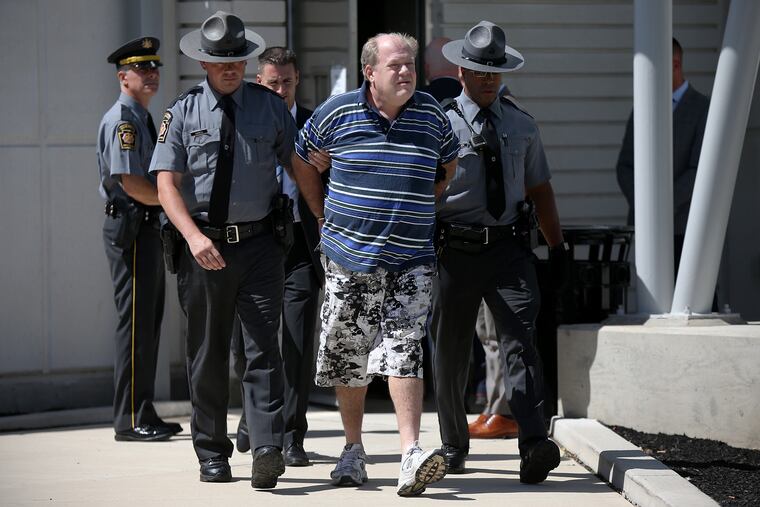Socks help solve 28-year-old cold case murder
Theodore Dill Donahue, 52, a pizza deliveryman, was long suspected in the 1991 killing of Denise Sharon Kulb, a former girlfriend. The 27-year-old mother's body was found in a wooded area of Delaware County. Donahue used the email handle Ted Bundy 1967, an apparent reference to a serial killer.

Philadelphia law enforcement officials Tuesday said they had solved a 28-year-old “cold case” murder with the arrest of Theodore Dill Donahue, a Germantown pizza deliveryman who was long a suspect in the 1991 slaying of Denise Sharon Kulb, 27, his former girlfriend.
Donahue, now 52, whose email handle is “Ted Bundy 1967," an apparent reference to the executed serial murderer, was arrested Tuesday morning and charged with murder, abuse of corpse, tampering with evidence, obstruction of justice, and false reports to police, Philadelphia District Attorney Larry Krasner said at a news conference at the Pennsylvania State Police station on Belmont Avenue.
As a handcuffed Donahue was walked from the building and put into a police SUV, he looked straight ahead and ignored reporters’ questions. “He’s not guilty. He denies the charges, and we will dispute it in court,” his attorney, R. Emmett Madden, said during a brief phone conversation.
The arrest by state police was made after “an extensive joint re-examination of the case,” said Krasner, who said State Trooper Andrew Martin in particular was key in cracking the case. He noted that Martin gained the free assistance of Temple University’s photography department to enhance crime-scene photographs.
The victim’s body was found on Nov. 12, 1991, in a wooded portion of an undeveloped cul-de-sac off Harvey Road in Chadds Ford Township, Delaware County. Kulb was a mother, daughter, sister, and friend who “deserved far better than to be killed and left in a location unknown to those who mourned her,” Krasner said.
It is believed Kulb’s body was moved there after she was murdered, authorities said. Her last known addresses were on Amber Street and Salaignac Street in Philadelphia.
Anthony Voci, supervisor of the district attorney’s Homicide Unit, said Donahue’s arrest nearly three decades after he allegedly killed Kulb “demonstrates our commitment to the ideal that there is no case, no amount of time, that we consider a lost cause.”
The homicide was originally investigated by police in Delaware County. The case was re-opened by the Criminal Investigation Assessment Unit of the state police in 2015, and the Philadelphia District Attorney’s Office joined the investigation in 2018 with the consent of the Delaware County District Attorney’s Office, which ceded jurisdiction, officials said.
Instead of relying on DNA or physical evidence, the case was built on new investigative tools, including photo-enhancing technology that connected a pair of separated socks, which proved to be a key piece of evidence, to Donahue, officials said.
Donahue’s changing statements over the years also cast doubt on his claims of innocence, Voci said.
On Oct. 1, 1991, Kulb moved into Donahue’s apartment on the 200 block of Salaignac in the Wissahickon section of Philadelphia. Two weeks later, she moved out. According to Donahue’s original statement that he gave state police, he last saw Kulb on Oct. 18, 1991, when they bought and used crack. They were robbed at knifepoint, he said, and she ran to get help.
But in 2015, when Donahue was re-interviewed by state police, he gave a different account, stating that the last time he saw Kulb was outside of a bar on Oct. 18.
She was seen alive by family members at a funeral on Oct. 19, 1991, and when her sister was later interviewed, she stated that Denise got into a fight with Donahue outside of the bar where the sister was employed.
Phone records show that Donahue and Kulb talked before they met on Oct. 19, the last day she was seen alive. On the afternoon of Nov. 12, 1991, Kulb’s body was found clothed only in a sweater, and piled on top were two pairs of pants, a T-shirt, a jacket, and one pale yellow sock.
Investigators from the Delaware County Coroner’s Office ruled the death a homicide. On Nov. 15, 1991, state troopers searched Donahue’s apartment and found one yellow sock that matched the sock found on the body, and a job application with Kulb’s name on it. The photos of the socks were later enhanced to make the connection between the apartment and the crime scene.
That day, Donahue was interviewed, and denied any involvement or knowledge of Kulb’s death, while admitting that his nickname was “Ted Bundy.” Over the next two days, Donahue called the state police to ask about the autopsy results and told troopers, in what they considered a nervous manner, that he would offer his help with the investigation, officials said.
Over the next several years, Donahue and other potential witnesses were interviewed or re-interviewed, and his story unraveled, Voci said. The interviews re-created Donahue’s telling others of how his old girlfriend was found face-down in the woods strangled, revealing details that no one but an eyewitness or the killer should have known, officials said.
Voci said Donahue did not confess to the slaying. He declined to say why the initial investigators did not give more weight to the matching yellow socks. “I can’t speak for what the investigators understood or believed at that point and time,” he said.
Voci said he was confident the passage of time will not hamper his office’s chances of winning a conviction. “Sometimes cases get better with time, just like wine does,” he said. “For instance, in 1991 we didn’t have multiple versions of his last interactions with the victim. Now we do. So that’s one example of how cases can get better.”